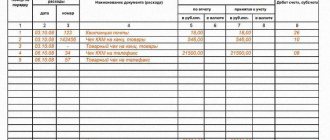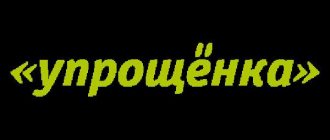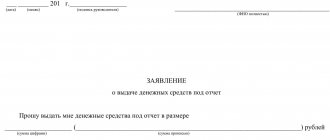Rules for issuing imprest amounts
Accountable amounts can be issued to any employee of the organization, provided that he has no debts on previous advances.
The basis for issuing money is a written statement from the employee, which indicates the timing, amount and purpose. The application must be signed by the manager. In recent years, non-cash payments to employees have been gaining popularity in state and municipal institutions. Therefore, money against the report can not only be given to the employee in cash through the cash register, but also transferred to the institution’s debit cash desk or to the employee’s bank card (letter of the Ministry of Finance of Russia dated August 25, 2014 No. 03-11-11/42288). The specific procedure for settlements with accountable persons is regulated by internal regulations on the issuance of cash and strict reporting forms.
It should be remembered that you can issue/transfer to an employee only the amount that is indicated in the application and approved by the head of the institution. Money is allocated for strictly defined purposes and provided for by the same statement.
When issuing or transferring accountable funds to a card, an accountant must keep track of two important points:
- Since the employee purchases goods (pays for services) in the interests of the institution, these transactions should be considered transactions between legal entities. This means that it is necessary to comply with the amount of cash payments between legal entities. Currently the upper limit is set at RUB 100,000. (Instruction of the Central Bank of the Russian Federation No. 3073-U).
- If, in the interests of the institution, an employee pays for goods/work/services from one counterparty, he must comply with the annual limit on the total amount of such purchases (Federal Law dated 04/05/13 No. 44-FZ). In this case, the payment method does not matter.
Basic Concepts
The accountable persons in any enterprise are citizens who are provided with sums of money. They are issued as an advance towards the implementation of certain business transactions in the future. And also for those who have to go on a business trip.
At the end of the activity for which the money was provided, the person who received it is obliged to draw up a report on the expenditure. All documents that can confirm the intended use of funds (checks, invoices, travel tickets, etc.) are attached to it.
If funds were allocated for economic work, then the deadline for submitting the report should be determined by the head of the organization. If the advance was issued for a business trip, the period depends on the type of trip:
- If it takes place within the territory of Russia, then the report should be submitted within three working days after return.
- When the departure was foreign, the traveler has ten days after completion to provide reports.
If, after completing all the work, the accountable person has unspent amounts, then they must be handed over to the cash desk of the enterprise. All money received must be spent strictly for its intended purpose. The report itself, after checking by accounting staff, must be endorsed by the head of the organization.
The accountable person may be an employee going on a business trip
If the person who received the advance does not report on the expenses made on time, then a debt appears. It must be revalued every month depending on the changing exchange rate of the Russian ruble to the currencies of other countries. In the balance sheet, the debt of such persons is reflected under the item specified in the current legislative acts.
Cash withdrawal or transfer to card
In accounting, the issuance/transfer of funds for reporting is reflected by the following entries:
In accounting, the issuance/transfer of funds for reporting is reflected by the following entries:
| Debit | Credit | Description |
| 0 208XX 560 “Increase in accounts receivable of accountable persons” | 0 20134 610 “Retirement of funds from the institution’s cash desk” | Funds in rubles were issued for reporting to an employee of the institution in cash or transferred to his personal bank card |
| 0 20111 610 “Retirement of institution funds from personal accounts with the treasury authority” (for budgetary and autonomous institutions) | ||
| 0 20121 610 “Disposal of funds from an institution to a credit institution” (for autonomous institutions that have an account with a credit institution) | ||
| 1 30405 XXX “Settlements for payments from the budget with the financial authority” (for government institutions) |
The transfer of accountable amounts to an institution's debit card is taken into account slightly differently. In essence, this is a transfer by an institution of funds between its accounts, which means that the accounts receivable of the accountable person will arise only when he pays for goods, work, and services. In accounting, these changes are recorded only after money is written off from the debit card account.
An institution can use its own debit card to issue funds to employees on account. In this case, it must submit two documents to the Federal Treasury authority at the place of service (or other financial authority of the corresponding budget). The first is an application to receive cash transferred to the card (f. 0531243) (clause 11 of Rules No. 10n). This must be done no later than the day before receiving funds.
The second document is a breakdown of the amounts of unused funds (deposited through an ATM or cash point) (f. 0531251). The transcript, signed by the manager and chief accountant, is sent to the treasury on the day the funds are deposited (clause 42 of Rules No. 10n). The institution submits the same transcript in order to return funds to the accounts of the Federal Treasury if they were only partially spent or were not used at all.
In general, an institution can both receive and deposit cash into a debit card account through ATMs or special dispensers. For this kind of settlements between institutions and the Federal Treasury, account 21003 “Settlements with the financial authority for cash” is defined (clause 230 of the Instructions for the Application of the Unified Chart of Accounts).
The table shows accounting records that reflect these transactions and documents:
| Debit | Credit | Description |
| 0 210 03 560 | 0 201 11 610 | Funds are debited from the institution's personal account to the institution's debit card |
| 0 201 34 510 | 0 210 03 660 | The institution's cash desk received funds cashed through an ATM or bank cash desk from a debit bank card opened for account 40116 |
| 0 208 26 830 | 0 201 34 610 | An amount of cash was issued from the cash register to pay for other work and services. |
| 0 201 23 660 | 0 201 34 610 | Removal of funds from the institution's cash desk when depositing cash using bank cards through an ATM (cash dispensing point, electronic terminal or other device) |
| 0 210 03 560 | 0 201 23 660 | Funds are credited to the institution's account through an ATM using a debit bank card opened for the account |
| 0 201 11 510 | 0 210 03 660 | The unclaimed amount was returned from the institution’s account to the accounts of the Federal Treasury |
Characteristics of account 71
Active-passive account 71 records expenses made by employees as a credit, and their payments as a debit. Synthetic accounting shows the total amounts of turnover and balances in the relationship between personnel and the organization in terms of production costs, and analytical registers specify the information.
Analysis of account 71 is organized for each amount in order to comply with the law, according to which three days are allocated (clause 6.3 of the Instructions) for reporting on the money received. For traveling employees, the countdown begins after arrival, for local workers - from the date of the cash receipt order. According to the information content, account 71 “Settlements with accountable persons” is a material accounting register and until the accounting department receives documents containing information about the expenditure of allocated funds, it is prohibited to issue the next amount to the employee.
The accounting policy approved by the organization determines whether 71 accounts will be active or passive. If it is determined that expenses are paid after they are incurred, then the balance will be permanently in credit. This option is used by organizations in which personnel expenses are characterized by small amounts and sporadic occurrences. The balance sheet for account 71 has a debit total if the accounting policy provides for the advance of expenses. Pre-issuance of money to employees is practiced by enterprises whose activities involve frequent, long business trips or constant purchases in cash.
With the active-passive method of organizing settlements with personnel, account 71 is constructed in the following order:
| Debit | Credit | |
| Balance at the beginning of the period in expanded form | Debt of employees to the organization | Debt of the organization to employees |
| Revolutions | Issuance of funds | |
| Purchase of materials, services | ||
| Expanded balance at the end of the period | The company's debt to employees | Employees' debt to the company |
71 accounting accounts are the registration of information about accountants not only for cash transactions, but also for non-cash transfers to personal bank cards of employees or corporate cards. Settlements with employees through financial institutions are not subject to the control of Central Bank Directives No. 3210 dated March 11, 2014, since the account. 71 does not correspond with 50 “Cash desk”. Consequently, there is no obligation to comply with the 3-day deadline for reporting for funds received and there is no restriction on issuing money to an employee who has not reported.
Report for sub-report
The employee must report for the funds issued in a strictly defined manner. First of all, pay attention to the deadline: the report is submitted to the accounting department no later than three working days from the moment the employee returns to work or from the end of the period for which the money was allocated.
An employee can submit a report in one of two options:
- advance report in form 0504049 with attached primary documents (tickets, checks, etc.);
- statement or cash order - if accountable funds were allocated for payments to individuals (salaries, fees, etc.).
On the front side of the advance report, the employee fills out information about himself: full name, personnel number, position, structural unit. On the reverse side, in columns 1 to 6, in separate entries, based on primary documents, he enters data on the funds spent: amount, expense item, date and number of the supporting document. Primary documents must be attached to the expense report and numbered in the same order as the entries in the report.
The accountant or manager accepts the report. Each institution establishes its own procedure and timing for reviewing the report as part of its internal accounting policy; legislation does not regulate this point.
Having received the advance report from the employee, the accountant checks whether it is filled out correctly and whether all documents are attached. Data on expenses that the institution accepts for accounting are entered in columns 7–10. Opposite each amount is the analytical account number.
The accountant reflects the expenses accepted by the institution for accounting as follows:
| Debit | Credit | Description |
| 0 10500 340 “Increase in the cost of inventories” | 0 208XX 660 “Reduction of accounts receivable of accountable persons” | Expenses accepted by the institution for accounting using funds issued on account |
| 0 10600 000 “Investments in non-financial assets” | 0 208XX 660 “Reduction of accounts receivable of accountable persons” | |
| 0 30200 000 “Settlements for accepted obligations” | 0 208XX 660 “Reduction of accounts receivable of accountable persons” | |
| 0 40120 000 “Expenditures of the current financial year” | 0 208XX 660 “Reduction of accounts receivable of accountable persons” | |
| 0 10900 000 “Costs for the production of finished products, performance of work, services” | 0 208XX 660 “Reduction of accounts receivable of accountable persons” |
A situation may arise when the employee did not spend all the funds or, on the contrary, invested his own. In the advance report, he enters these amounts in the Remaining/Overexpenditure column. In accounting, this will be reflected as a debt of the reporting person or institution. The overexpenditure is recorded and reimbursed to the employee in the same manner as the advance payment, and to return the balance, the accountant creates a record using one of the options:
| Debit | Credit | Description |
| 0 20134 510 “Receipts of funds to the institution’s cash desk” | 0 208XX 660 “Reduction of accounts receivable of accountable persons” | Accountable funds were returned to the institution's cash desk |
| 0 20111 510 “Receipts of funds from the institution from personal accounts in the treasury body” (for budgetary and autonomous institutions) | 0 208XX 660 “Reduction of accounts receivable of accountable persons” | Accountable funds were returned to the institution’s personal account |
| 0 20121 510 “Receipts of funds from an institution in a credit institution” (for autonomous institutions that have an account in a credit institution) | 0 208XX 660 “Reduction of accounts receivable of accountable persons” | Accountable funds were returned to the institution’s personal account |
| 1 30405 000 “Settlements for payments from the budget with the financial authority” (for government institutions) | 0 208XX 660 “Reduction of accounts receivable of accountable persons” | Accountable funds were returned to the institution’s personal account |
Postings for accounting on account 71
According to Section VI of the instructions for using the chart of accounts (order of the Ministry of Finance of the Russian Federation dated October 31, 2000 No. 94n), account 71 “Settlements with accountable persons”:
- debited to cash accounts 50 “Cash” (if cash is given to the accountant) or 51 (when funds are given in non-cash form);
- is credited to accounts that record expenses related to the employer’s business activities, and to cash accounts in the event of the return of unspent amounts.
Amounts for which the employee did not report must be returned to the employer - such an operation will be recorded as a credit to account 71 and a debit to cash accounts 50, 51.
If the balance of money is in debt to the employee, then it should be taken into account in the debit of account 94 “Shortages and losses from damage to valuables” in correspondence with account 71. Such debt can be deducted from the employee’s salary, in this case a posting will be made Dt 70 Kt 94 When the employer does not have the opportunity to withhold the debt from the salary, account 73 “Settlements with personnel for other operations” is used, and the posting will look like this: Dt 73 Kt 94.
Note! If an employee has lost (or forgotten to take) documents confirming expenses, then the decision to reimburse the employee for expenses is made by the head of the company. The supporting document will be an explanatory note from the employee attached to the advance report, and the basis for accepting the advance report will be an order from the director of the company.
Let us summarize the information about which accounts account 71 can correspond with.
| Account 71 “Settlements with accountable persons” corresponds to: | |||
| by debit with accounts | on a loan with accounts | ||
| the name of the operation | Corr. check | the name of the operation | Corr. check |
| Funds were issued for accounting or to compensate for overexpenditure of accountable amounts | 50, 51, 52 | Acquisition of material assets, goods | 07, 08, 10, 41 |
| Funds spent on expenses and household needs | 20, 23, 25, 26, 44 | ||
| VAT on purchased goods and materials | 19 | ||
| Return of the balance of accountable money | 50, 51 | ||
| There was a delay in the return of accountable amounts | 94 | ||
The expense report submitted to the accounting department is checked by the accountant, and its approval (by signing) is carried out by the manager (or individual entrepreneur). After this, the accountant can make all the necessary entries for expenses in accounting.
ConsultantPlus experts explained how to take into account the expenses of an advance report when calculating income tax. Get trial access to the system for free and move on to the Ready-made solution.
How to take into account debt and collect it from accountable persons
The accountant may have difficulties taking into account accountable amounts if the employee did not submit a report on time for the money spent or did not return the remaining funds from payment for goods/services/work to the institution's cash desk.
If an employee is forced to return accountable amounts, the institution can recover them based on the order of the manager (Article 243 of the Labor Code of the Russian Federation). The time to make a decision is one month after the end of the period established for the return of the advance payment and submission of the report. Please note: the employee must familiarize himself with the order and give his consent to the collection in writing, otherwise the issue of returning the imputed amounts will be resolved in court.
The maximum allowable amount of deduction should be observed (Article 138 of the Labor Code of the Russian Federation) - no more than 20% of wages minus personal income tax.
In accounting, debt collection entries will look like this:
| Debit | Credit | Description |
| 0 30403 830 “Reduction of accounts payable for deductions from wage payments” | 0 20800 660 “Reduction of accounts receivable of accountable persons” | Reflected deduction from wages |
If at any stage the procedure is violated, the issue of return of funds by the accountable person is resolved through the court. The court may decide not in favor of the institution, then the penalty will be considered unfounded. In this case, the accountant writes off the amount as unrealistic for debt collection based on the certificate (f. 0504833).
These transactions in accounting will look like this:
| Debit | Credit | Description |
| 0 40120 273 “Extraordinary expenses for operations with assets” or 0 20930 560 “Increase in accounts receivable for damage to compensate for the costs of the state, state (municipal) institutions” | 0 20800 000 “Settlements with accountable persons” | The debt of an accountable person has been written off based on a court decision |
| ZB 04 “Debt of insolvent debtors” | Reflected on the balance sheet by a simultaneous operation |
The write-off date will be the date of the court order. If the litigation continues or the debtor repays the amount, the debt must be written off from the off-balance sheet account.
To record such situations, the Funds and Settlements Accounting Card (f. 0504051) is used. The data in it is presented by debtor and by type of payment.
Accounting procedure
As a rule, the purpose of spending funds is to purchase services or goods. In this case, the employee will act on behalf of the company. Consequently, the operation will be subject to the rules relating to legal entities. The maximum amount of settlements between legal entities is 100,000 rubles based on Bank Directive No. 1843-U dated June 20, 2007. If this limit is not observed, officials will face a fine of 4,000-5,000 rubles. The fine for legal entities will be 40,000-50,000 rubles.
The issuance of funds on account requires compliance with these standards:
- The expenditure report must be submitted to the accounting department within 3 days after the date of expenditure.
- The amount can only be received by the person for whom it is intended.
- A new advance can only be received after a report has been drawn up for the previous amount.
The manager needs to issue an order on the procedure for issuing amounts. This document defines these points:
- List of employees who have the right to receive the amount under the report.
- The period for which the money is provided.
- The procedure for issuing an advance.
Accountable persons who are mentioned in the order must be familiarized with it against their signature. The procedure for issuing and writing off funds must be recorded in the accounting policy.
Funds are provided based on a written application. It needs to be directed to the head of the company. Money is issued only if the manager considers the requirements
the application is justified. In this case, the manager must send a corresponding order to the accounting department.
Issued funds are written off on the basis of an advance report drawn up by the accountable person. Documents confirming the operation are attached to it: checks, receipts, contracts. For accounting purposes, they can only be used if they are compiled in a unified form.
When checking reports, you need to pay attention to these points:
- The information on cash receipts and sales receipts should be similar. Dates in documents should not fall on weekends.
- The sales receipt must contain all the required details. The cashier's signature and seal must also be present.
- The sales receipt must contain a specific list of items that were purchased. For example, not “stationery”, but “pens, pencils and notebooks”.
After completing the transaction, the employee may have money left over. The balance must be returned to the cashier on the basis of a cash receipt order. Also, there may not be enough funds to complete the operation. That is, the employee will have to add his own money to the amount. Overexpenditure is also compensated to the employee using a cash order.
What should I do if, after completing the transaction, the employee still has funds, but he did not return them to the cashier? In this case, the manager can withhold funds from the salary. The basis for the collection is Article 137 of the Labor Code of the Russian Federation. However, this is only possible if the following conditions are met:
- Withholding can be made within a month from the date of the balance return deadline.
- The withholding amount cannot be more than 20%.
- The employee agrees with the grounds and amount of deductions.
- There is a written statement from the employee that he agrees to the procedure.
Important! If the conditions discussed are not met, the employer can challenge the withholding.
Accounting for accountable amounts using specific examples
To purchase stationery, the secretary of the Prokopyevskaya Village Hospital, A. I. Altufeva, was given 3,500 rubles from the cash register. The funds are allocated from the institution’s own income. The purchased stationery will be used in the activities of the institution, not subject to VAT. The total purchase price is RUB 2,900. (including VAT - 442 rubles 37 kopecks), costs for courier delivery of stationery - 200 rubles. (including VAT - 30 rubles 50 kopecks).
Operations for the purchase of stationery will be reflected in the institution’s accounting records:
| Debit | Credit | Amount, rubles | Contents of operation |
| 2 208 34 560 | 2 201 34 610 | 3 500 | Funds were issued against the report for the purchase of stationery |
| 2 106 34 340 | 2 208 34 660 | 2 900 | Costs for purchasing stationery are taken into account |
| 2 106 34 340 | 2 208 34 660 | 200 | The cost of courier delivery of office supplies to the institution is written off as an increase in their cost (including “input” VAT) |
| 2 105 36 340 | 2 106 34 340 | 3 100 (2 900 + 200) | Purchased stationery items are included in materials |
| 2 109 80 272 | 2 105 36 440 | 3 100 | The cost of stationery put into operation has been written off |
| 2 201 34 510 | 2 208 34 660 | 400 | Accountable funds were returned to the institution's cash desk |
Reflection of debt of accountable persons in the balance sheet
In the balance sheet (Form 1), debt on accountable amounts, like any other debt, is reflected either in the balance sheet asset (if it is a receivable) or in its liability (if it is a payable). Such a balance cannot be reduced.
The maturity of debt on accountable amounts, as a rule, does not exceed a year, so it is usually accounted for as short-term, falling into the balance sheet lines:
- 1230 “Accounts receivable” - in assets;
- 1520 “Accounts payable” - in liability.
From 2021, financial statements will be submitted exclusively in electronic form. Paper forms will no longer be accepted.
In the simplified form of the balance sheet, the debit balance on account 71 will go to the line “Financial and other current assets”, and the credit balance will go to the line “Accounts payable”.










